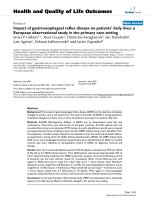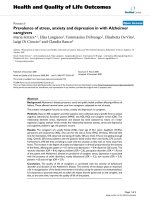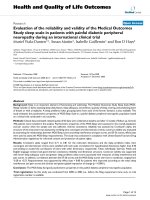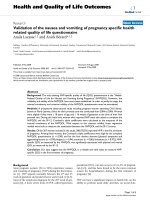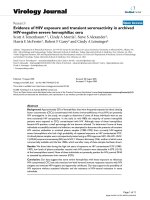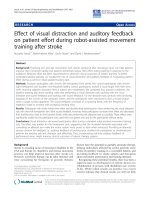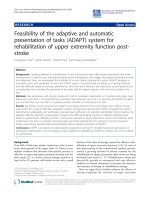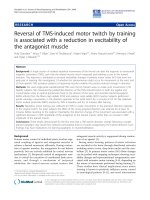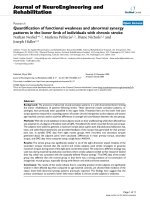báo cáo hóa học:" Knowledge of HIV transmission and condom use among HIV-positive heterosexual men and women in Guatemala" docx
Bạn đang xem bản rút gọn của tài liệu. Xem và tải ngay bản đầy đủ của tài liệu tại đây (169.32 KB, 19 trang )
This Provisional PDF corresponds to the article as it appeared upon acceptance. Fully formatted
PDF and full text (HTML) versions will be made available soon.
Knowledge of HIV transmission and condom use among HIV-positive
heterosexual men and women in Guatemala
Journal of the International AIDS Society 2011, 14:58 doi:10.1186/1758-2652-14-58
Juan J Delgado Hurtado ()
Marcela Pineda ()
Iris Cazali ()
Carlos Mejia ()
ISSN 1758-2652
Article type Research
Submission date 2 June 2011
Acceptance date 19 December 2011
Publication date 19 December 2011
Article URL />This peer-reviewed article was published immediately upon acceptance. It can be downloaded,
printed and distributed freely for any purposes (see copyright notice below).
Articles in Journal of the International AIDS Society are listed in PubMed and archived at PubMed
Central.
For information about publishing your research in Journal of the International AIDS Society or any
BioMed Central journal, go to
/>For information about other BioMed Central publications go to
/>Journal of the International
AIDS Society
© 2011 Delgado Hurtado et al. ; licensee BioMed Central Ltd.
This is an open access article distributed under the terms of the Creative Commons Attribution License ( />which permits unrestricted use, distribution, and reproduction in any medium, provided the original work is properly cited.
Knowledge of HIV transmission and condom use among HIV-
positive heterosexual men and women in Guatemala
Juan J Delgado Hurtado
1§
, Marcela Pineda
1
, Iris Cazali
1,2
, Carlos Mejía
2
1
Universidad Francisco Marroquín, School of Medicine, Guatemala City, Guatemala
2
Infectious Diseases Unit, Roosevelt Hospital, Guatemala City, Guatemala
§
Corresponding author: Juan Jose Delgado Hurtado, School of Medicine, Universidad
Francisco Marroquín, Guatemala City, Guatemala. Tel: (+502) 2413-3235
Email addresses:
§
JJD:
MP:
IC:
CM:
Abstract
Background
The prevalence of HIV/AIDS in Guatemala among the general population is 0.79%, and 94% of
transmission is directly related to sexual contact. Studies have been conducted on high-
prevalence HIV-positive populations (men who have sex with men, commercial sex workers and
prisoners). Heterosexual transmission has gained importance in the epidemic in Central America.
To our knowledge, no study addressing knowledge of mechanisms of HIV transmission and
condom use has been done on HIV-positive heterosexual men and women.
Methods
A closed-ended structured interview that addressed knowledge of mechanisms of HIV
transmission and condom use was conducted on 283 heterosexual HIV-positive men (54.8%) and
women (45.2%) outpatients who attend the Roosevelt Hospital’s Clinic of Infectious Diseases in
Guatemala City. Differences between selected characteristics were examined for significance
using the Chi-square test. A multiple logistic regression was done to determine socio-
demographic variables associated with inconsistent condom use.
Results
Of the interviewed persons, 68.5% were either living with a partner or married, and 94.3% were
currently using antiretroviral therapy. Most respondents knew the mechanisms of transmission of
HIV. 81.7% and 87.3% reported always using a condom with their regular and casual sexual
partner in the past year, respectively. There was no statistically difference in condom use
according to the patient’s formal education, gender, type of partner (regular or casual)or number
of sexual partners, According to the interviewees, 72% of sexual partners in the past year were
either HIV negative or of an unknown serostatus. Potentially, these HIV-negative persons are at
risk of contracting the virus. Among the main reasons given for not using a condom were: “my
partner did not want to use a condom”; and “the condom irritates or makes my partner
uncomfortable”.
Conclusions
Since no socio-demographic or sexual behavior variable was associated with inconsistent
condom use, we recommend intensive and regular condom counselling for every heterosexual
HIV-positive outpatient who attends the clinic. Further studies should be done to determine
condom use negotiation between partners; and to determine social, interpersonal and
psychological factors that might affect the decision to use a condom or not.
Background
Guatemala is the most populated country in Central America, with almost 14 million inhabitants
[1], 3 million of whom live in Guatemala City, its capital [2]. It is estimated that 51% of the
country’s population live in poverty [3]. Guatemala’s population annual growth rate is 2.06%
[1], which is higher than that of the rest of Latin America. According to the Human Development
Index, it is categorized as a medium-developed country with a current ranking of 131 out of 187
[4].
The prevalence of HIV/AIDS among the general population is 0.79 % [1]. It is estimated that
94% of transmission is directly related to sexual contact and that 5% of the new cases are
transmitted vertically. The HIV-positive population lives predominantly in urban areas along
commercially important roads and migration routes to the United States and Mexico. Most of the
cases (80%) have occurred in persons in the range of 15 to 49 years of age. The prevalence of
HIV among men who have sex with men (MSM) is 18.3%, among commercial sex workers
1.09% and among prison inmates 3.24% [1].
The number of HIV cases in women is increasing. According to information provided by the two
HIV clinics located in Guatemala City (Luis Angel Garcia, San Juan de Dios Hospital and
Infectious Diseases Clinic, Roosevelt Hospital), in 2004, 74% of new HIV cases were women
without any risk factor other than having sexual relations with their regular partner [5]. This
feminization of the epidemic is probably a result of having sex with infected men who, in their
turn, have had extramarital sexual relations with HIV-positive people [5].
To provide effective measures that diminish HIV transmission, it is important to study the
knowledge of mechanisms of HIV transmission, sexual behaviour and condom use among
heterosexual HIV-positive patients. In some countries, this type of transmission has been
increasingly examined. In Guatemala, there has been some research done on condom use and
knowledge of HIV transmission in sex workers [6] and MSM [7].
According to a study done on MSM, 82.3% of respondents expressed consistently using a
condom with their casual partner in the previous month, while 62.8% reported consistently using
condoms with their regular partner in the previous month. In total, 80.1% of the sample had used
a condom in their most recent sexual relation. This study also addressed knowledge of
mechanisms of HIV transmission. Of the respondents, 21.9 % thought mutual faithfulness was a
method of preventing transmission of HIV [7]. A study done on female sex workers reported that
78.8% and 96.1% of the sample expressed using a condom consistently with their casual and
regular sex clients, respectively, in the previous month [6].
A study that examined the impact HIV voluntary counselling and testing had on self-reported
behavioural risk (in the previous three months) of people living with HIV (PLHIV) found that it
resulted in a modification of risky behaviour. Initially, before being counselled and diagnosed
with HIV; 12.19% (5) of the sample (41 persons) stated that they had never had unprotected
sexual relations in the prior three months. On the follow up visit, three months after counselling
and diagnosis, 73.17% reported never having unprotected sexual relations in the prior three
months [8]. This difference was statistically significant.
Heterosexual transmission has gained importance in the epidemic in Central America. In some
countries, this type of transmission has been increasingly examined, but in Guatemala to our
knowledge, few studies have been done on heterosexual people. Therefore, the objectives of this
study were to describe the socio-demographic characteristics of the sample, to determine the
knowledge of the mechanisms of HIV transmission, to determine condom use among
heterosexual PLHIV, and to identify variables associated with inconsistent condom use. This can
help generate more focused counselling for non-condom-adherent heterosexual PLHIV.
Methods
This cross-sectional descriptive study was conducted in 2010 at the Roosevelt Hospital’s Clinic
of Infectious Diseases, an outpatient clinic, in Guatemala City, under the approval of the
Roosevelt Hospital Ethics’ Committee and the Research Department of Universidad Francisco
Marroquín.
Persons eligible to participate in this study were PLHIV, both men and women, attending the
clinic; they were 18 years or older, sexually active in the past year and had been diagnosed with
HIV between one and five years earlier by double ELISA or Western Blot. Subjects who had
same-sex relations in the preceding year, worked as commercial sex workers or had been
imprisoned were excluded from the sample.
The subjects were approached in the clinic’s waiting area. Before being interviewed, they had to
sign an informed consent form. A closed-ended, structured survey interview was conducted on
those who were eligible according to the selection criteria. The survey included socio-
demographic characteristics, mechanisms of transmission of HIV, and sexual behaviour,
including condom use and reasons for not using a condom. The interview was held in a private
counselling room within the clinic by an interviewer previously trained by the main
investigators.
Interviewees were presented with hypothetical situations, asked if the situations could lead to the
transmission of HIV/ AIDS, and were questioned on ways to prevent HIV transmission. The
answers were either “yes”, “no” or “I do not know”. They were asked to classify their condom
use consistency (based on a Likert-type scale) in the past six months and during the past year
with their regular and casual partners (if they had any). Condom use in the most recent sexual
relation was questioned. Persons were asked if they had any reason for not using a condom in the
past year through a closed-question approach, allowing multiple reasons. If another reason not
included in the list was mentioned, it was added in the data.
For the analysis, Epi Info 2000 was used. Differences between selected characteristics were
examined for significance using the Chi-square test. A multiple logistic regression was done to
determine the socio-demographic characteristics associated with inconsistent condom use. The
variables of interest were: formal education (stratified as having completed primary education or
lower and having completed some secondary education or higher), age, marital status and
number of sexual partners in the previous year (classified as one or more than one sexual
partner). The type of sexual partner was categorized as regular or casual. A regular sex partner
was defined as the person with whom the patient had been sexually involved for more than three
months, whether there was an affective link between them or not. Casual partners were defined
as those with whom the interviewee had had sexual intercourse without the intention of seeing
him/her again or had been sexually involved for less than three months. These definitions were
read to interviewees before conducting the relevant part of the interview.
Results
In all, 466 persons were approached in the waiting area of the clinic; of these, 60% (283) were
included in this study based on the inclusion and exclusion criteria. The respondent rate of those
persons who met the inclusion criteria was 100%.
The socio-demographic characteristics of the sample are shown on Table 1. At the time of the
study, 94.3% of the interviewed persons (267) were undergoing antiretroviral treatment.
Regarding knowledge of mechanism of HIV transmission, 93.3% of the patients were aware that
HIV could not be transmitted through kisses, and 69.6% were aware that it could not be
transmitted through mosquito bites. The mechanisms by which most respondents thought that
HIV could be transmitted were: sharing needles when using intravenous drugs (94.3%), having
unprotected sex (98.9%), having blood transfusions (96.5%), from the infected mother to the
baby during pregnancy or birth (87.3%), from an infected mother to the breastfeeding baby
(88.7%), and having anal sex (86.2%). They were aware that that mutual faithfulness (86.9%),
using a condom (97.5%), abstinence (73.9%) and using a condom in a vaginal (97.2%) or anal
sexual relation (72.4%) were effective ways to prevent HIV transmission.
When asked about sexual partner, 84.8% of the 283 subjects said they had had only one sexual
partner in the past year, 15.2% more than one sexual partner, and 4.34% five or more partners.
When the distinction was made between regular and casual sexual partners, 85.2% reported
having had at least one regular sexual partner and 36.2% at least one casual partner in the
previous 12 months. Male respondents had more sexual partners than females (χ2=23.67, CI
95%, p=0.00001), specifically casual partners (χ2=13.85, CI 95%, p=0.00001).
Respondents were asked to classify their sexual partners in the past year as casual or regular and
to define their HIV serostatus as positive, negative or unknown. The results are provided in
Table 2. In total, 89.6% of the reported sexual casual partners were of an unknown HIV
serostatus according to the interviewees, while 58.33% of the reported regular partners were
positive according to the interviewees. This difference is statistically significant (χ2=333.2, CI
95%, p <0.0001).
There was a difference in condom use in the previous year depending on the type of sexual
partner, 81.7% and 87.3% of the patients reported always using a condom with their regular and
casual sexual partner, respectively; however, this difference was not statistically significant (OR
1.55, χ
2
=1.34, CI 95%, p=0.24). Likewise, there was no statistically significant difference in
condom use in the past six months according to formal education of the sample (χ2=1.12, CI
95%, p=0.29), gender (χ2=2.33, CI 95%, p=0.09) and the number of sexual partners (OR 0.37,
χ2=0.00, CI 95%, p=1). When asked about their most recent sexual relation, 90.4% (255)
reported using a condom and 83% (235) reported using a condom in every sexual relation in the
previous six months.
At least one reason was given for not using a condom in the past year by 78 people (27.5%). The
main reasons mentioned were: “my partner did not want to use a condom” (48.7%); “the condom
irritates or makes my partner uncomfortable” (30.8%); and “I do not want to use a condom”
(29.5%). Two people (2.6%) reported not using a condom in the past year because they were, or
their partner was, under the effect of alcohol or another drug. Other reasons mentioned for not
using a condom are provided in Table 3.
Discussion
Our results show that heterosexual PLHIV recognize condoms as an effective method of
preventing HIV transmission and that most of them use condoms. Some of them do not
acknowledge its value for the prevention of HIV in anal intercourse. This could be due to the fact
that counselling might be focused on vaginal sexual relations.
Most of the women properly identified both pregnancy in an HIV-infected mother and
breastfeeding as a possible means of transmission of the virus to the baby. Heterosexual PLHIV
recognized mutual faithfulness as a method of preventing transmission of HIV in a larger
percentage than that reported by a study among MSM [7].
Self-reported condom use in the past six months and most recent sexual relation is higher than
that reported in other studies [9,10]. Condom use consistency in the previous three months
among PLHIV in Guatemala in another study [8] is lower than condom use consistency reported
by the sample in our study in the previous six months. Nevertheless, the sample in the other
study was different from ours: homosexual and bisexual PLHIV were not excluded, they were
more recently diagnosed with HIV, they had received less condom counselling, and they were
not undergoing antiretroviral therapy. This might explain the differences.
It appears as if a larger percentage of heterosexual PLHIV report using a condom consistently
than MSM and commercial sex workers, according to reports by other studies [6,7]. However,
these studies have addressed condom consistency in the prior month, which is different from
what was addressed in our study. Reported condom use in the most recent sexual relation by
MSM in a study done in Guatemala is 80.1% [7], which is less than what was found in our
results (90.4%).
Overall, male participants had more sexual partners than female participants, predominantly
casual ones. When subjects reported having casual partners, in most cases, they did not know
their HIV serostatus. A large percentage, 72% (364), of the total number of sexual partners in the
previous year (507) were either HIV negative (94) or of an unknown serostatus (270).
Potentially, these HIV-negative partners are at risk of contracting the virus.
When they were asked to cite the reasons for not using a condom in the past year, the main
reason given was that their partner did not want to use it. This is a factor that should be addressed
during counselling at the clinic, focusing on and strengthening condom use negotiation. In this
population, it appears that alcohol and drugs do not affect condom use, as has been found in
other studies conducted in other countries [9,10].
Some authors have described changes in sexual behaviour related to the use of antiretroviral
therapy [11]. Since most of this sample was currently on antiretroviral therapy, no distinctions
could be made. This gives an opportunity for future research focused on recently initiated
patients on highly active antiretroviral therapy and modifications in their sexual behaviour.
There is an ongoing debate on the superiority of a self-administered questionnaire over a guided
interview [12]. In this study, the interviewer-administered form was preferred, because of the
expected low level of education of the population. On the other hand, patients attending the
clinic have received counselling on condom use, and this could explain the greater adherence
reported by patients.
We think that patients may be conditioned to answer with what they are expected to say. This
could be a potential bias leading to an underestimation of condom non-adherence. In fact, more
respondents gave reasons for not using a condom, even when they had responded to an earlier
question by saying that they always used a condom. Confirmation of condom adherence could be
aided with biological markers of new diagnosis of other sexually transmitted infections. Future
studies could relate biological markers and reported sexual behaviour.
Conclusions
This study shows that there is a group of HIV-positive persons who continue to have sexual
relations without using condoms, even after counselling. It also contributes to explaining why
patients are not using condoms, which can generate new and more focused strategies to promote
condom negotiation among partners and emphasize correct and consistent condom use in every
sexual relation, including anal intercourse.
Since no socio-demographic variable was associated with inconsistent condom use, we
recommend intensive and regular condom counselling for every heterosexual outpatient who
attends the clinic. This study did not address social, interpersonal (including disclosure) and
psychological factors that might determine condom use among heterosexual PLHIV. These
issues should be explored during counselling and can be subjects of further research.
Competing interests
The authors declare that they have no competing interests.
Authors’ contributions
JJD and MP contributed to the design of the study, performed the statistical analysis and wrote
the first draft of the manuscript. IC and CM participated in the design and coordination of the
study and critically reviewed the manuscript. All authors read and approved the final manuscript.
Acknowledgements
We thank the Hospital Roosevelt’s Infectious Diseases personnel for helping in the recruitment
of the patients and the interviewer.
References
1. UNAIDS: Report UNGASS Guatemala 2010. Guatemala: 2010.
[ />ittedbycountries/guatemala_2010_country_progress_report_en.pdf]
2. Instituto Nacional de Estadística, INE: Encuesta Nacional de Condiciones de Vida, ENCOVI-
2006. [
3. USAID: HIV/AIDS profile. 2009.
[ ]
4. UNDP: Guatemala. Country profile of human development indicators; 2010.
[
5. Programa Global de VIH/SIDA: Reduciendo la vulnerabilidad al VIH/SIDA en
Centroamérica Guatemala: Situación del VIH/SIDA y respuesta a la epidemia. Banco
Mundial; 2006. [ />1103037153392/CAHIVAIDSGuatemalaFINALSPA.pdf]
6. Estudio TRaC de VIH/ SIDA entre trabajadoras sexuales femeninas en Ciudad de
Guatemala, Escuintla, Izabal, Quetzaltenango y Suchitepequez. Segunda Ronda. División de
investigación de PSI; 2008. [
7. Estudio TRaC de VIH/SIDA Hombres que tienen sexo con otros Hombres en Guatemala,
Quetzaltenango, Escuintla, Suchitepéquez e Izabal. Segunda Ronda. División de
investigación de PSI; 2009.
[
8. Samayoa B, Anderson MR, O’Sullivan LF, Patricia K, Pacheco A, Matos A, Reyes DA,
Setru S, Arathoon E: Does HIV VCT reduce risk behavior? An observational study in
Guatemala City. Current HIV Research 2010, 8:121-126.
9. Dave SS, Stephenson J, Mercey DE, Panahmand N, Jungmann E: Sexual behavior, condom
use, and disclosure of HIV status in HIV infected heterosexual individuals attending as
inner London HIV clinic. Sex Trans Infect 2006, 82:117-120.
10. Clark RA, Kissinger P, Bedimo AL, Dunn P, Albertin H: Determination of factors
associated with condom use among women infected with human immunoddefficiency
virus. Int J STD AIDS 1997, 8:229-233.
11. Dukers NH, Goudsmit J, de Wit JB, Prins M, Weverling GJ, Coutinho RA: Sexual risk
behaviour relates to the virological and immunological improvements during highly
active antiretroviral therapy in HIV-1 infection. AIDS 2001, 15:369-378.
12. Crepaz N, Marks G: Towards an understanding of sexual risk behavior in people living
with HIV: a review of social, psychological, and medical findings. AIDS 2002, 16:135-
149.
Tables
Table 1. Socio-demographic characteristics of the sample
n=283
Gender
Male 54.8% (155)
Female 45.2% (128)
Age
35.3±10.05
Marital
status
Living
with
partner
43.8% (124)
Married 24.7% (70)
Single 17.0% (48)
Separated 10.6% (30)
Widowed 3.2% (9)
Divorced 0.7% (2)
Formal
education
Completed
primary
education
or lower
50.2% (142)
Completed
some
secondary
education
or higher
31.4% (89)
None 18.4% (52)
Literate
Yes 82.9% (232)
No 17.1% (48)
Table 2. Reported HIV serostatus according to sexual partner type
Table 3. Reported reasons for not using a condom in the past year
Reason reported (n=78)
My partner did not want to use a condom 48.7%
The condom irritates or makes my partner uncomfortable 30.8%
Condom irritates me or makes me uncomfortable 29.5%
I did not want to use a condom 23.1%
I do not like making love with a condom 21.8%
I do not think it is important since my partner is also HIV positive
16.7%
It was my regular partner 15.4%
We did not have a condom 14.1%
We felt safe 14.1%
My partner loves me 12.8%
My partner thinks he or she cannot get infected with HIV 11.5%
I want to, or my partner wants to get pregnant 10.3%
My partner does not know I am HIV positive 9.0%
We forgot to use a condom 7.7%
Partner
HIV
serostatus
Regular
44.9%
(n=228)
Casual
55.0%
(n=279)
Positive
58.33%
(133)
3.58% (10)
Negative
32.89% (75)
6.81% (19)
Unknown
8.77% (20)
89.60% (250)
We do not have sexual relations with other persons 6.4%
I cannot discuss with my partner the use of condom 6.4%
I think my partner cannot get infected with HIV 2.6%
I was or my partner was under the effect of alcohol 2.6%

